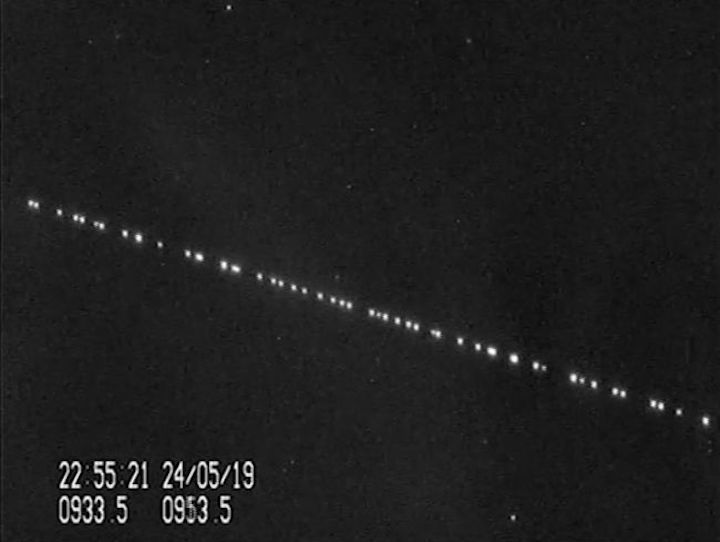
22.01.2020
Da der gestrige "SkyTrain" (18.31-18.40 MEZ) der Starlink-Satelliten recht hoch Richtung Zenit kamen und gut sichtbar waren, kamen die Beobachtungs-Anfragen minütlich rein:
Lennestadt, 2x Bielefeld, Fulda, Dortmund, Paderborn, Limburg, Butzbach, Weilburg, Wetzlar, Bad Ems, Ilvesheim, Bensheim, Hadamar, Frankenberg, Brakel, Eschwege, Heidelberg, Oebisfelde, Uelzen,
Göttingen, Erfurt, Karlsruhe, Tauberbischofsheim, Hanau, Buchen, Weinheim, Seckach, Pfungstadt, Weilburg, Gladenbach, Allendorf/Eder, Hildesheim, Schopsdorf.
Stand. 19.30 MEZ / 21.01.2020
CENAP-Michelstadt
+++
Mit dieser nachfolgenden Beobachtungsmeldung waren es dann 35 Meldungen die uns Gestern erreichten:
Name: => U.G.
Email: => xxxxxxxxxxxxx
Nachricht: => Guten Abend Herr Köhler,
Heute Abend haben wir über Butzbach ca 100 UFOs - wie an einer Perlenschnur gezogen von
Westen nach Osten über den Himmel ziehen sehen.Es war in sehr hoher Höhe und sah aus,
wie Sterne, handelt sich aber sicher um unnatürliche Objekte? Herzl Dank
+++
Gestern kontaktierte uns auch die Redaktion der Heilbronner Stimme, welche eine Anfrage mit Fotos erhalten hatte vom Vorabend (20.01.2020) und wissen wollte ob CENAP eine Lösung hätte:
Auf Facebook hat uns ein Leser angeschrieben, der gestern Abend etwas seltsames beobachtet hat
(Bilder habe ich angehängt):
E.W. schreibt:Hallo ich habe heut abend 19:15 in Obergimpern Lichter am Himmel
gesehen die in einer perfekt geraden Linie durch die Luft geflogen sind und dann wieder
verschwunden sind
Diese Bilder konnte ich machen vielleicht haben ein paar andere Leute das auch gesehen oder
können erklären um was es sich handelt
Waren bestimmt 50 „Sterne“ hintereinander am Himmel die sich dann wieder aufgelöst haben.
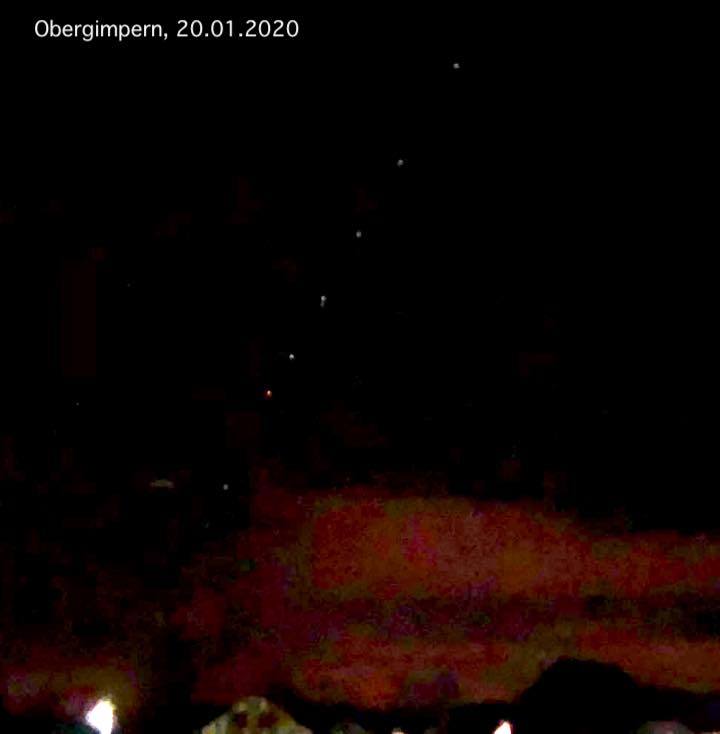
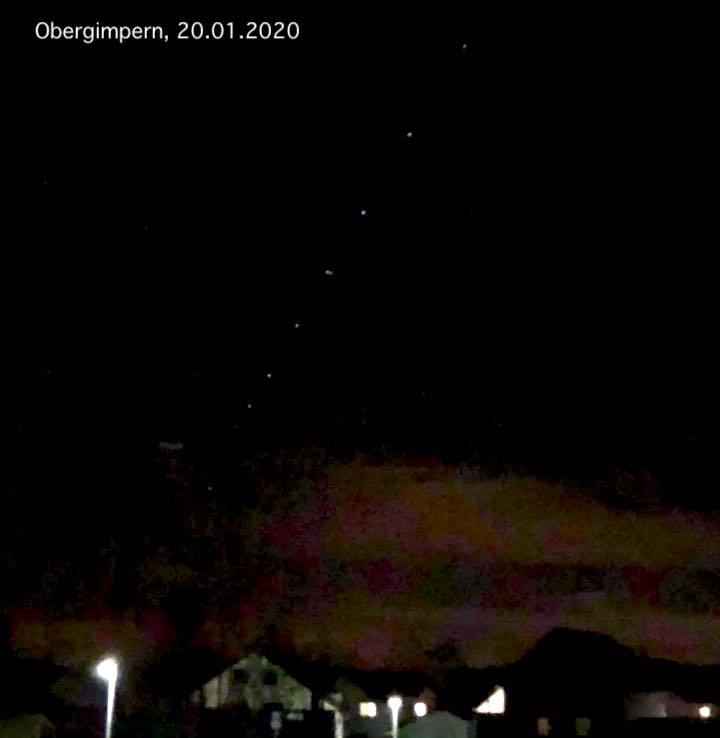
Fotos: E.W. Obergimpern
+++

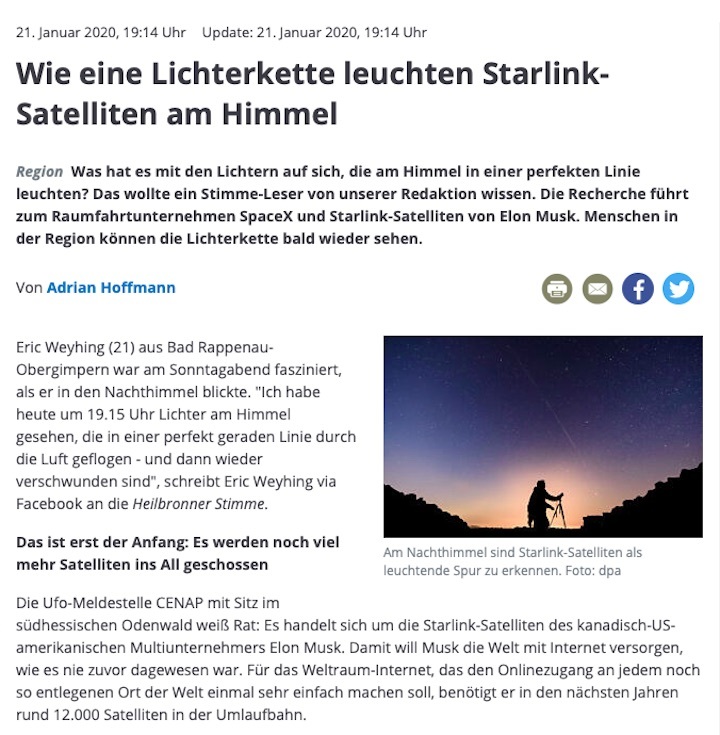
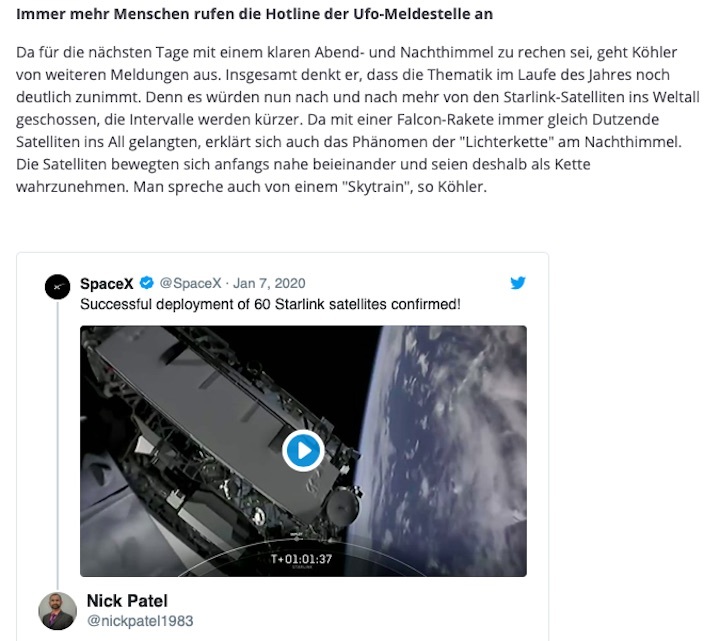



Quelle: Heilbronner Stimme
+++
----
Update: 21.00 MEZ

Heute Abend war der Norden an der Reihe mit klarer Sicht auf die Starlink-Satelliten und wir bekamen Meldungen per Kontakt-Formular, E-Mail und Tel-Anrufen:
Name: => M.M.
Email: => xxxxxxxxxxxxxxxx
Nachricht: => Guten Abend,
gegen kurz vor 19 Uhr entdeckte ich am Himmel (Süd-West in 26316 Varel) eine Schnur von
Sternen die in die Höhe nach Osten zogen, alle mit stets gleichem Verhalten: erst dicht hinter
einander und je höher sie stiegen, desto größer wurde der Abstand bis sie in der Höhe nicht
mehr zu sehen waren. Es waren hunderte, die immer auf der gleichen Strecke wanderten.
Nun wandern bloß noch mal Einzelne vorbei. Ein Video habe ich davon mit dem Handy
aufgenommen. Vielleicht können Sie uns dieses Phänomen erklären.
Freundliche Grüße aus Varel
M. M.
+++
Name: => D.C.
Email: => xxxxxxxxxxxxx
Nachricht: => ich habe,heute 22.01.2020 um ca 19.00 Uhr wie eine Perlenschnur
etwa 20 -30 Lichtpunkte (Sateliten) über Wilhelmshaven von West nach Ost gesehen.
C.D.
+++
Weitere Beobachtungen kamen aus: Neustrelitz, Waren, Walow, Banzkow, Bockhorn, Schwanewede
Stand 21.00 MEZ
CENAP-Michelstadt
----
Update: 23.01.2020
.

23.01.2020
Eine weitere Starlink-Satelliten Beobachtung von Gestern erreichte uns per E-Mail heute aus Wilhelmshaven so wir damit 2 Meldungen von gleichem Beobachtungsort haben und insgesamt von Gestern 9 Meldungen vorliegen haben.
Daher ist es gut, das in Thüringen über den mdr Starlink-Satelliten Aufklärungs-Berichte zu finden waren!
CENAP-Michelstadt
+++

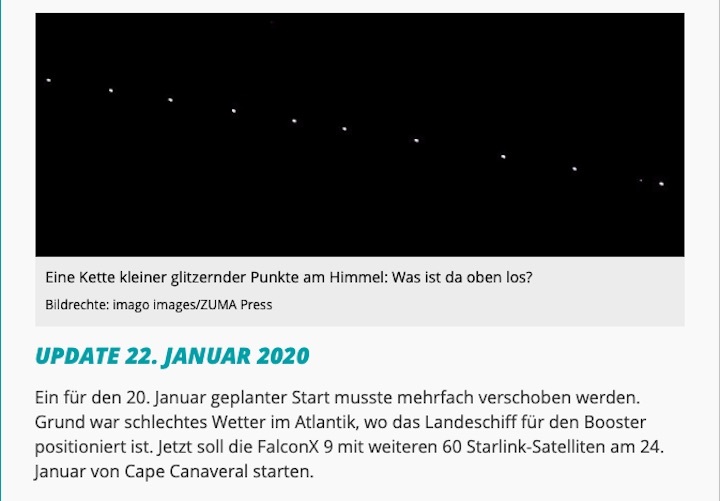
Quelle: mdr
+++

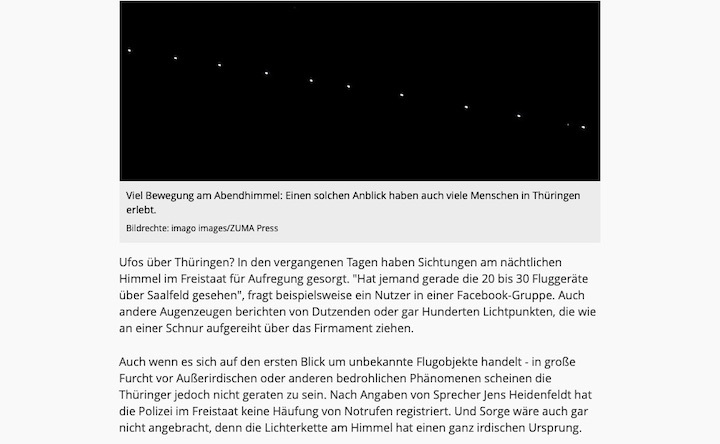
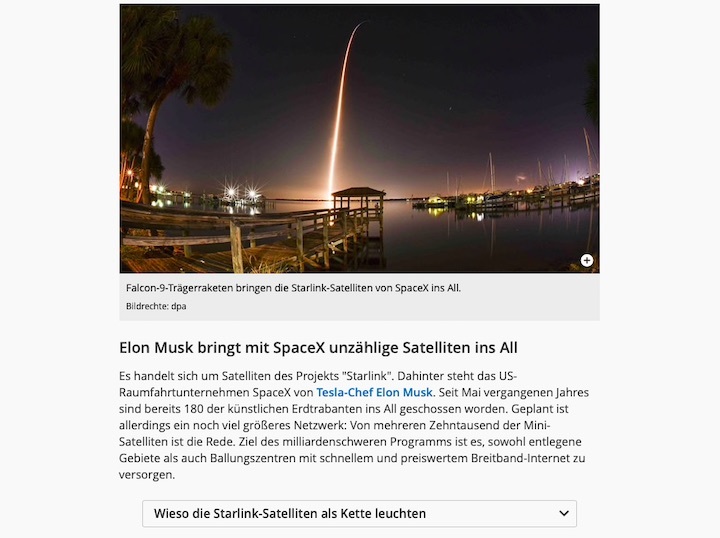

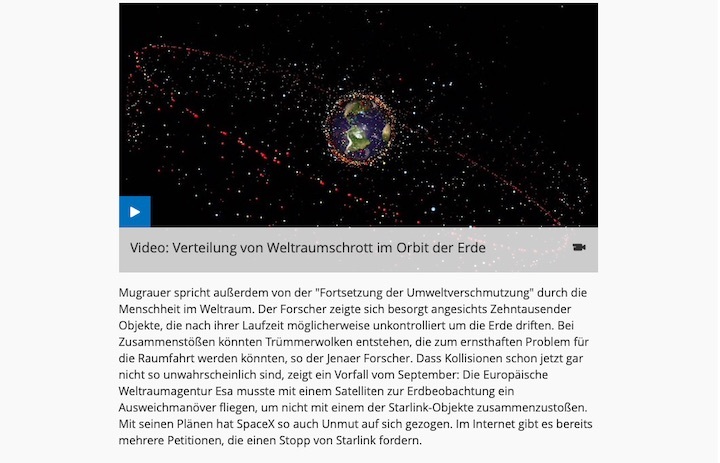
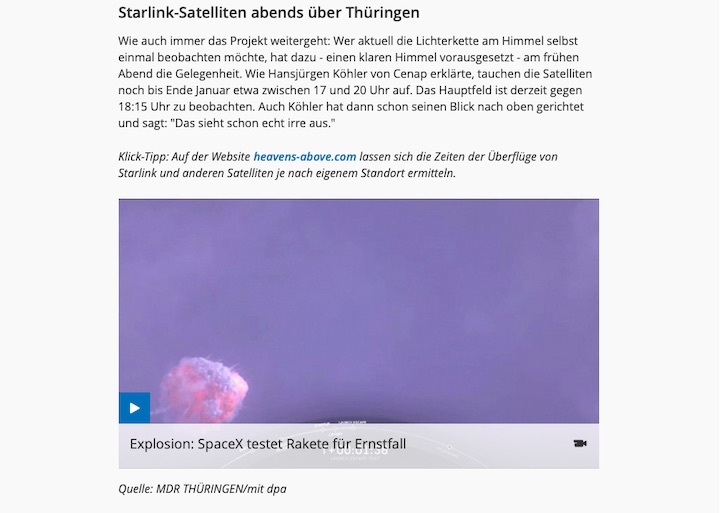
Quelle: mdr
----
Update: 24.01.2020
.

24.01.2020
Weitere Meldungen bekamen wir über E-Mail von Beobachtungen der Starlink-Satelliten von Gestern (23.01.2020) aus Stade, Gnarrenburg, Magdeburg, Saerbeck, Nützen, Wolfsburg, Bremen, Hemmoor.
+++
Heute erreichten uns über Kontaktformular und E-Mail Beobachtungen der Starlink-Satelliten aus Dresden, Freiberg, Marienberg, Aalen, Wertingen.
Stand 20.00 MEZ
CENAP-Michelstadt
----
Update: 26.01.2020
.

26.01.2020
Durch die derzeitige Medienarbeit mit der Aufklärung über die Erscheinungsweise der Starlink-Satelliten, ist es ruhiger geworden bei unserer UFO-Meldestelle, welches aber sicherlich auch auf die Wetterlagezurück zu führen ist. Daher sind wir gespannt wie der nächste Start der 4.Starlink-Satelliten am Montag für Auswirkungen hat.
CENAP-Michelstadt
+++
Update: 20.30 MEZ
Beobachtungen der Starlink-Satelliten erreichten unsere UFO-Meldestelle heute Abend aus dem Norden von Westoverledingen, Wardenburg und Esterwegen.
CENAP-Michelstadt
+++

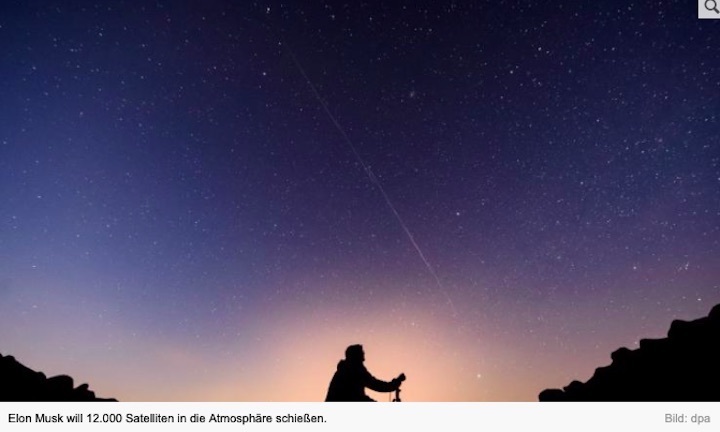

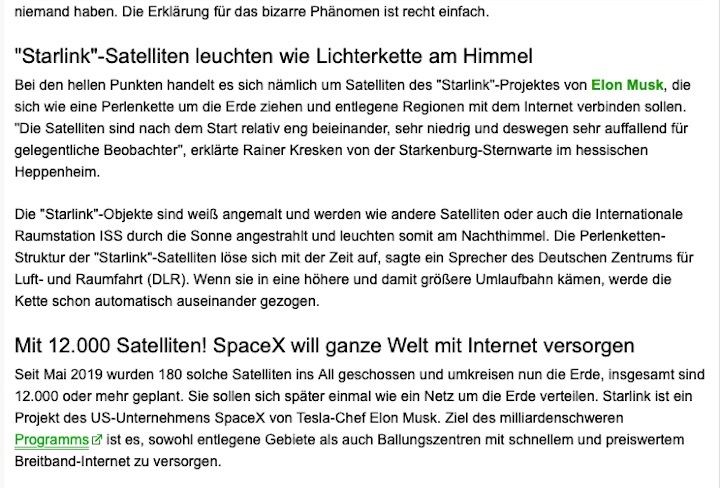

Quelle: news.de
+++
Überflugdaten der nächsten Tage (26.01.-31.01.2020)
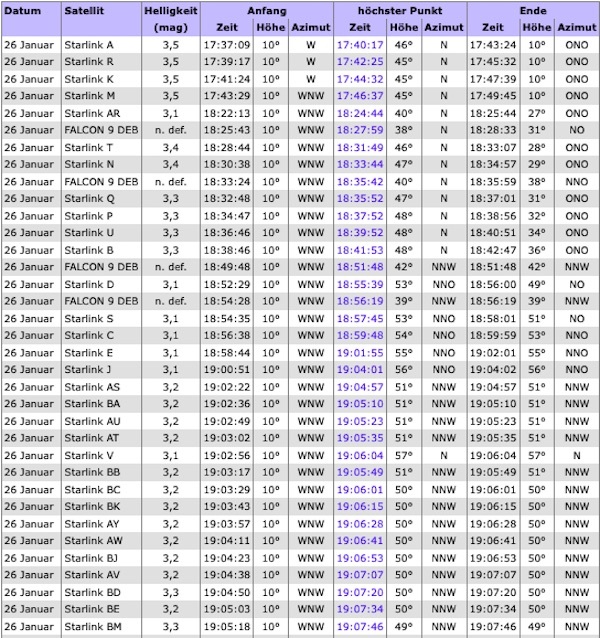
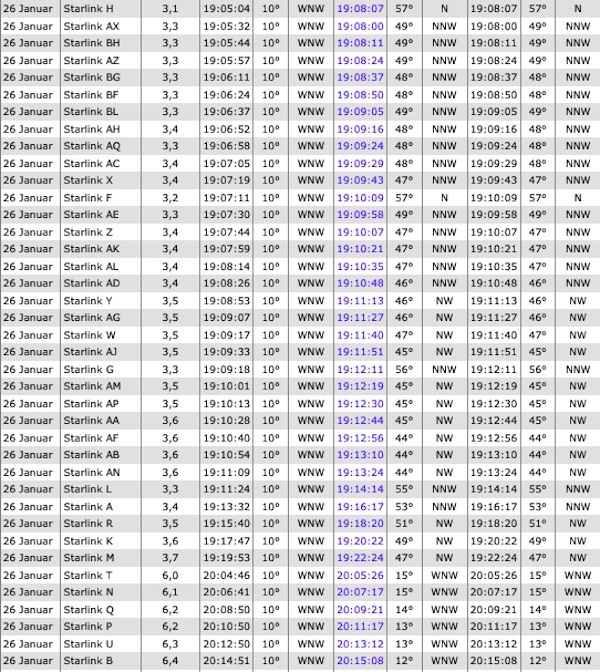
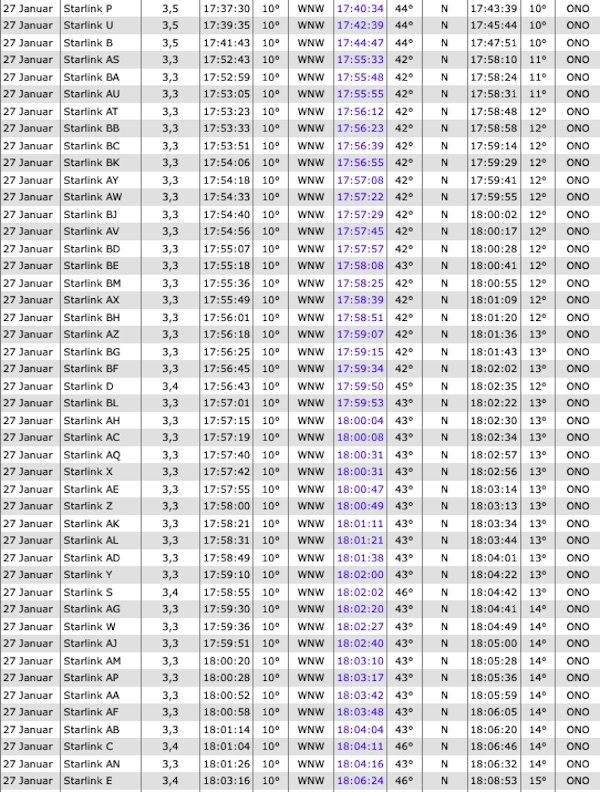
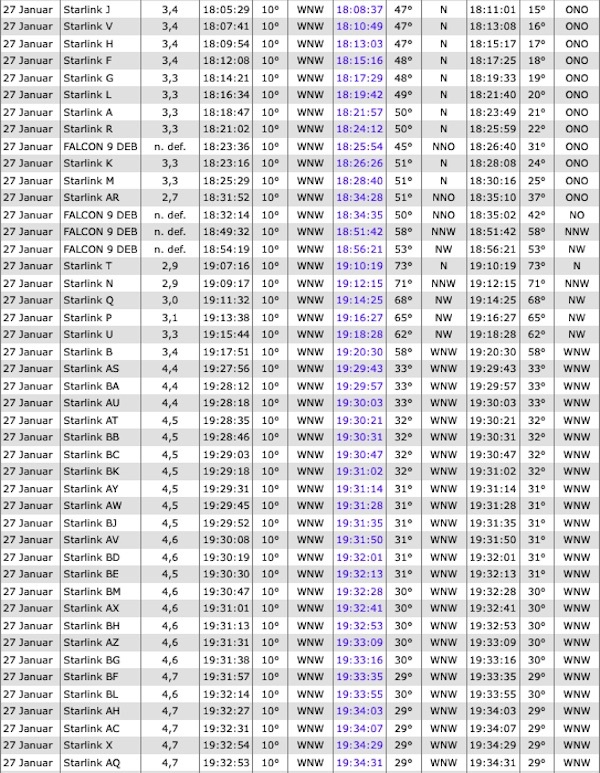
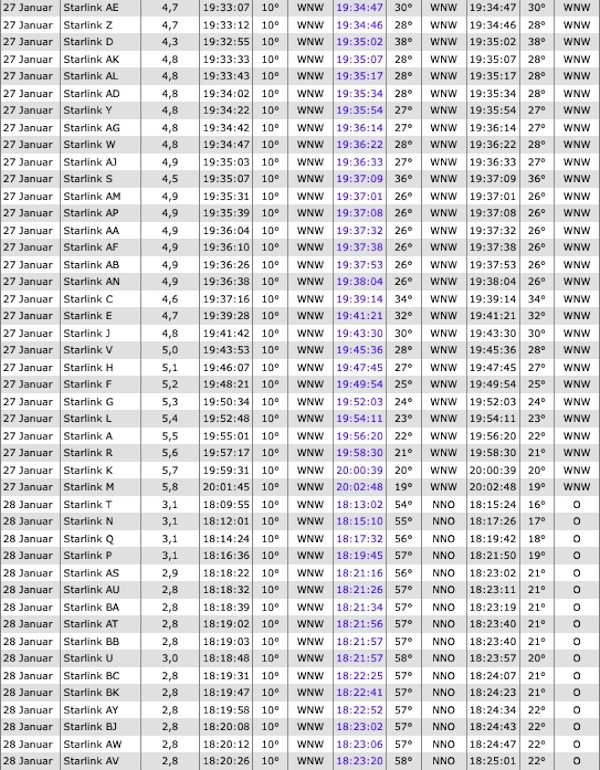
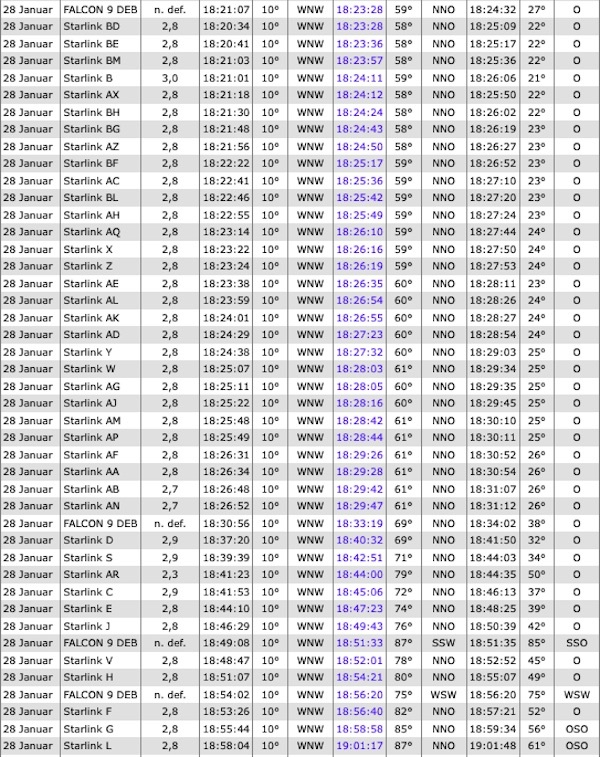
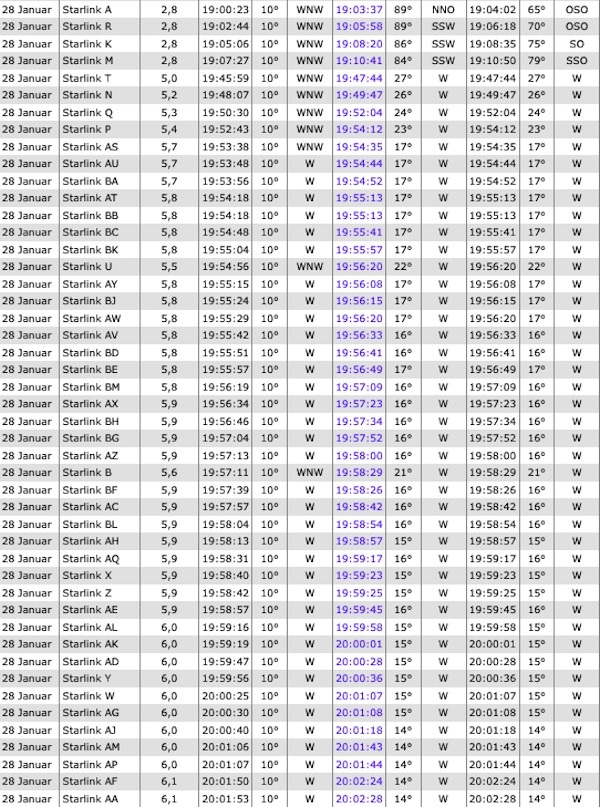
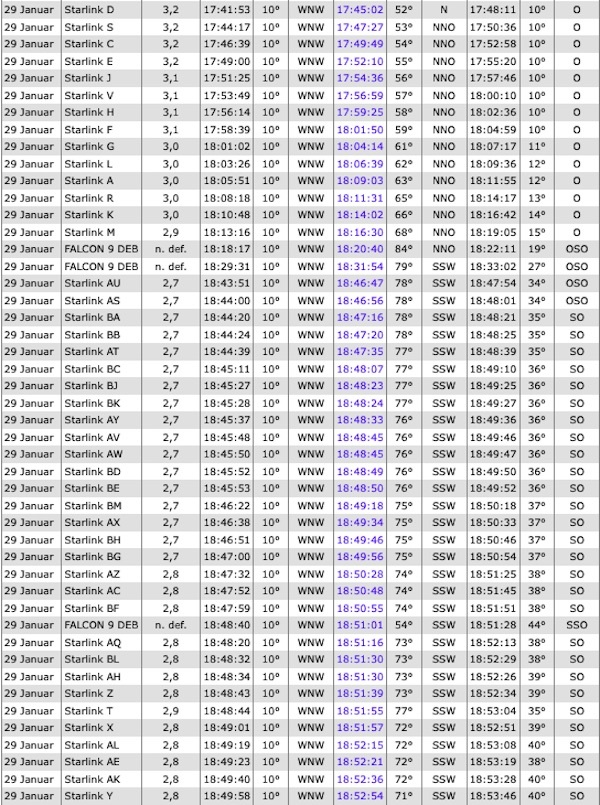

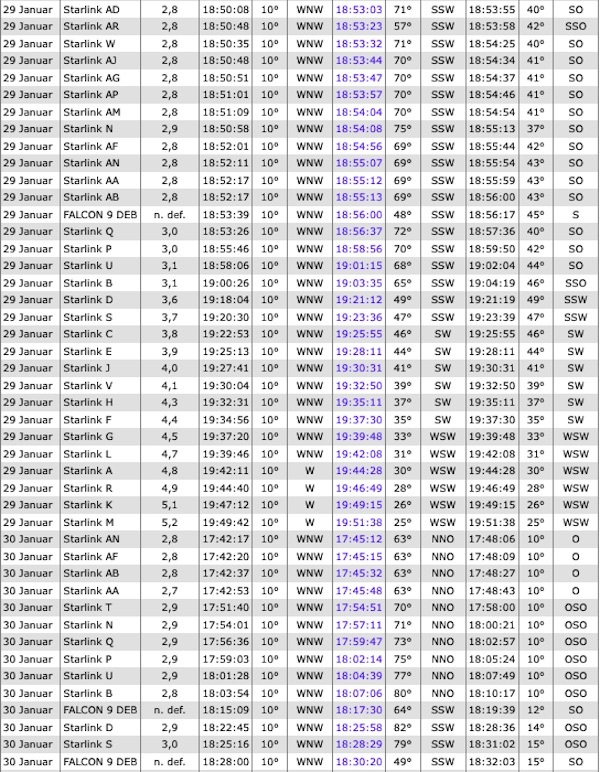

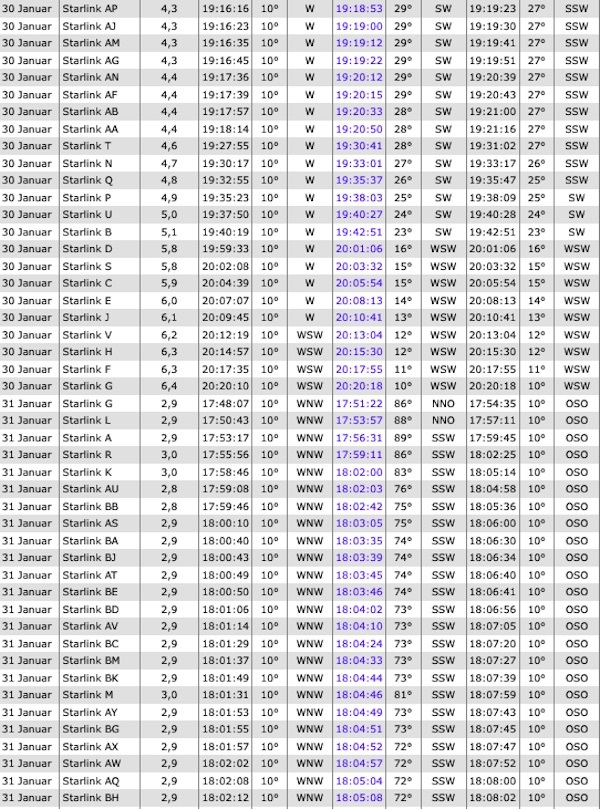
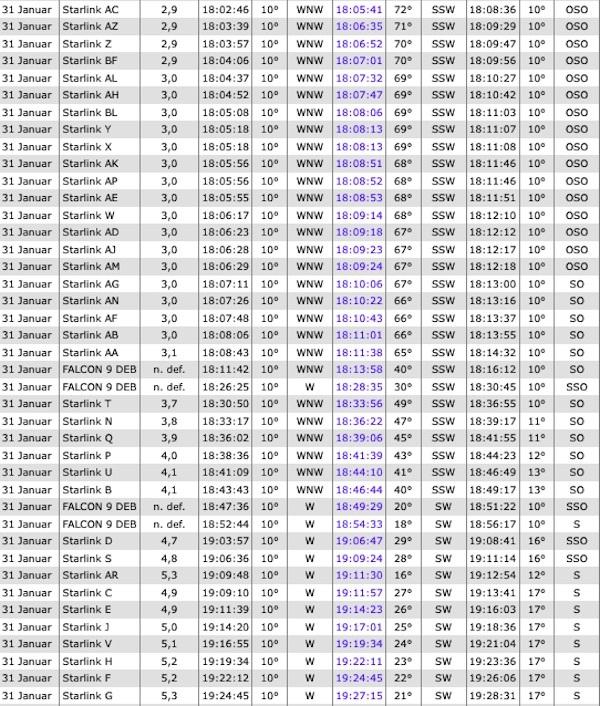

Quelle: HeavensAbove
----
Update: 27.01.2020
.



Quelle: Frankfurter Rundschau
----
Update: 31.01.2020
.

Merklich ruhiger ist es bei den Meldungen um die Starlink-Satelliten derzeit, trotz zusätzlicher in den Orbit gebrachten 60 Starlink-Satelliten welche jetzt insgesamt 240 umfasst. Meldungen bekamen wir nur die letzten Abende wegen Venus, welche nahe der Mondsichel war und in Wolkenlücken kurz erfasst werden konnte. Dabei verunsicherte die Zufalls-Beobachter die ziehenden Wolken,da man glaubte das helle Objekt fliege um den Mond...
Das Wetter soll ja über Deutschland vorweg dichte Bewölkung mit Regen haben, daher gehen wir erst wieder von Meldungen aus, wenn es auflockert und der klare Himmel zu sehen ist.
CENAP-Michelstadt
+++
SpaceX launches 60 new Starlink satellites, sticks rocket landing at sea
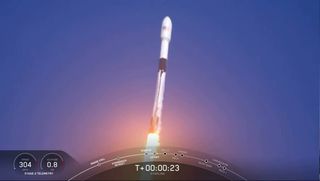
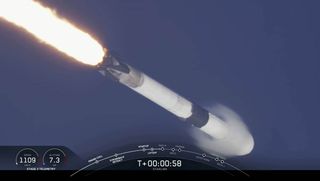
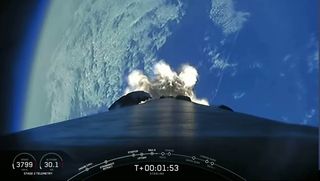
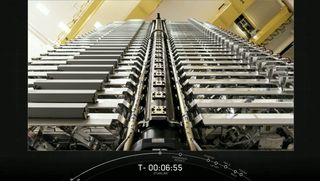
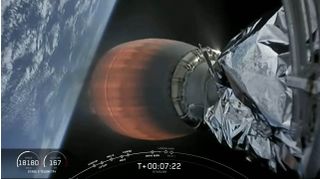
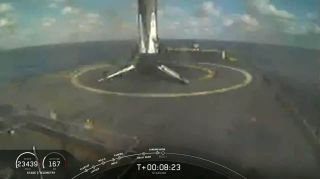
The star of this mission, the Falcon 9 first stage dubbed B1051.3 by SpaceX, previously lofted a Crew Dragon capsule as part of the company’s uncrewed mission to the space station (Demo-1) as well as a trio of Earth-observing satellites for Canada.
Following the successful launch, the rocket's first stage gently touched down on a SpaceX's drone ship landing platform "Of Course I Still Love You" in the Atlantic Ocean, marking the company's 49th booster recovery.
SpaceX designed its souped up Falcon 9 rocket to fly as many as many as 10 times with only light refurbishments in between. The company has yet to fly a booster five times, but continues to rack up veterans with three or four flights, proving their capability.
A Growing Constellation
Today's launch is part of SpaceX's goal of connecting the globe with its Starlink network. Each satellite is identical, weighing in at roughly 485 lbs. (220 kg), and is part of a larger network that aims to provide internet coverage to the world below. With this launch, it brings SpaceX's burgeoning constellation up to 240, making it the largest in orbit to date.
But SpaceX is not the only aerospace company with dreams of global connectivity. OneWeb launched its first set of six satellites in 2019, and Amazon hopes to launch its own constellation soon. However, SpaceX (with its own rockets) is the first to amass a sizable constellation.
Elon Musk, SpaceX CEO and founder, has said the company will need at least 400 satellites in orbit to provide minimal coverage, and at least 800 to provide moderate coverage. With this launch, the private spaceflight company is over halfway to the minimal coverage mark and says service could begin sometime this year. When that happens, the first places to receive coverage would be portions of the U.S. and Canada.
How Starlink works
SpaceX's Starlink project has one simple goal: to provide constant high-speed internet access to users around the world. Currently technology limitations often leave remote and rural areas without access; SpaceX wants to change that.
To access the internet, we rely on wireless cell towers or cables routed into our homes and offices. To that end, massive communications satellites will beam down internet coverage down from their orbital perched high above the Earth, in what's known as geostationary orbit (typically 22,000 miles up). The signal has to travel such a long distance, which translates to slower connections speeds.
By operating at a lower altitude (and with more satellites), SpaceX says it can mitigate this issue and provide reliable coverage at an affordable price.
But at what cost?
Astronomical nuisance?
Not everyone is thrilled about the idea of SpaceX's new mega-constellation. Astronomers have voiced concerns that the satellites could interfere with crucial scientific observations.
SpaceX's Starlink satellites stand out as they march across the night sky. That's because they’re incredibly bright, appearing as a train of bright dots as they orbit. Just how bright they were shocked and concerned scientists. Many were nervous that the Starlink constellation (and the others that will follow it) could interfere with their work.
Astronomers rely on ground-based telescopes to take long-exposure images of astronomical objects they want to study. When something bright passes in front of the telescope's field of view, it can obscure the image, and the observer has to figure out what caused it.
Musk and SpaceX listened to the concerns of astronomers and have experimented with ways of reducing the satellite’s brightness. One satellite in the previous batch was coated in a special material to make it appear darker in orbit.
Once the dark coating has been tested, SpaceX will decide how effective it is and whether or not the whole fleet will receive the same treatment.
During live launch commentary today, Starlink engineer Lauren Lyons said the satellite with that dark coating is still making its way to its final orbit, so more time will be needed for SpaceX to complete its tests.
Falling fairings
SpaceX has proven that it can successfully reuse its rocket boosters, but the company wants to take the notion of reusability one step further by recovering and refurbishing payload fairings. After today's launch, SpaceX successfully "caught" one half of the payload fairing with one of its net-wielding boats, known as "Ms. Tree."
The rocket’s nose cane is comprised of two halves (also known as payload fairings), which are designed to protect the payload during launch. SpaceX has equipped each fairing with its own navigation system that allows it to glide gently back to Earth. The company hopes this will facilitate the recovery and reuse of the fairing.
With each piece fetching roughly $3 million, SpaceX hopes to save some money by reusing them on future flights. To that end, the company has outfitted two of its recovery vessels with giant nets. Acting as mobile catcher's mitts, SpaceX hopes that it will be able to snag a fairing in each net.
To date, GO Ms. Tree (the vessel formerly known as Mr. Steven) has now made three successful catches. The second boat, GO Ms. Chief has yet to snag a falling fairing.
Quelle: SC

